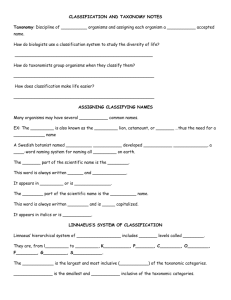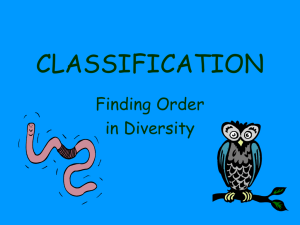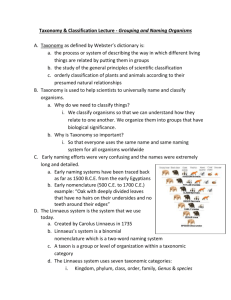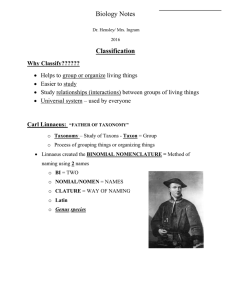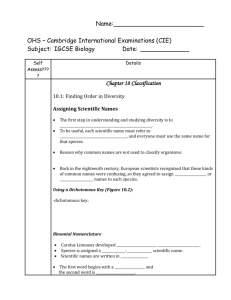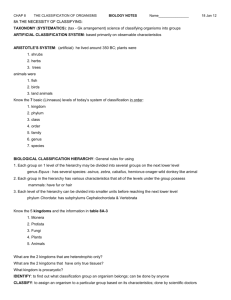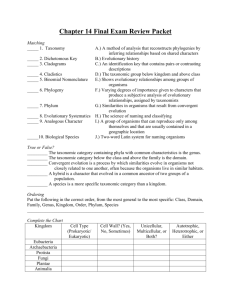CLASSIFICATION
advertisement
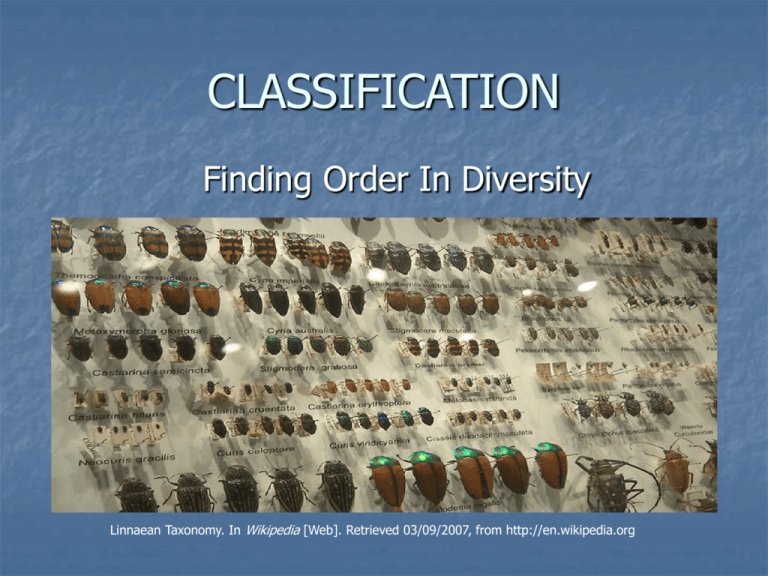
CLASSIFICATION Finding Order In Diversity Linnaean Taxonomy. In Wikipedia [Web]. Retrieved 03/09/2007, from http://en.wikipedia.org Definition of Taxonomy Discipline of classifying organisms and assigning each organism a universally accepted name 1 Leptinotarsa decemlineata Colorado potato beetle Why Classify? 1. To study the diversity of life, biologists use a classification system to name organisms and group them in a logical manner. 2. Taxonomists are able to organize organisms into groups that have biological importance. Why Classify? 3. Classification makes life easier. What are some ways we classify in our daily living? Assigning Scientific Names 1. Using common names is confusing because many organisms may have several different common names. 2. For example, the cougar is also known as the mountain lion, puma or catamount…thus the need for a scientific name. Scientific name: Puma concolor Assigning Scientific Names 3. A Swedish botanist named Carolus Linnaeus developed a two-word naming system for naming all species on Earth. 4. This two-word naming system is called Binomial Nomenclature. 2 Assigning Scientific Names 5. The first part of the scientific name is the genus name. This word is always written first with the first letter capitalized. This name appears in italics or is underlined. 6. The second part of the scientific name is the species name. This word is always written second and is not capitalized. This name also appears in italics or is underlined. Write the scientific name for humans: Genus name: Homo Species name: sapien Homo sapien or H. sapien Linnaeus’ System of Classification 1. Linnaeus’ hierarchical system of classification includes seven levels. They are, from largest to smallest, kingdom, phylum, class, order, family, genus, and species. Kingdom Phylum Class Order 2. In taxonomic nomenclature, each level is called a taxon (plural: taxa) or taxonomic category. Family Genus Species Linnaeus’ System of Classification 3. The kingdom is the largest and most inclusive (includes) of the taxonomic categories. 4. Species is the smallest and least inclusive of the taxonomic categories. 5. The more taxonomic categories that two organisms share, the more closely related they are considered to be. What do the scientific names of each bear tell you about their similarity to each other? Ursus arctos Ursus maritimus Ailuropoda melanoleuca Application of Linnaeus’ Classification System Organism Kingdom Phylum Class Order Family Genus Species Cat Animalia Chordata Mammalia Carnivora Felidae Felis domesticus Wolf Animalia Chordata Mammalia Carnivora Canidae Canis lupus Fly Animalia Arthropoda Insecta Diptera Muscidae Musca domestica Application of Linnaeus’ Classification Systmem 1. What type of animal is M. domestica? 2. Which two animals listed on the table are most closely related? 3. At what classification level does the evolutionary relationship between cats and wolves diverge (become different)? Family Level Evolutionary Classification 1. Darwin’s theories on descent with modification have led to the study of phylogeny, which is the study of evolutionary relationships among organisms. 2. Biologists group organisms into categories that represent lines of evolutionary descent or phylogeny and not just physical similarities. 3. Grouping organisms based on their evolutionary history is called evolutionary classification. Evolutionary Classification and Cladograms 1. Cladograms are tree-like diagrams that show the evolutionary relationships among a group of organisms Domain Eukarya Domain Archaea Domain Bacteria Three Domains Cladogram EVOLUTIONARY CLASSIFICATION A B C D E F Clade or lineage Speciation:formation of two New species from one T I M E Evolutionary Classification and Cladograms 2. Cladistic analysis identifies and considers new characteristics that arise as lineages evolve over time. 3. Derived characters are those that appear in recent parts of a lineage but not in its older members. 4. When a derived characteristics appears ahead of an organism listed on a cladogram, the organism lacks that derived characteristics. 5. When a derived characteristics appears below, beneath, or before the organism, the organism possesses or has that derived characteristics. CLADOGRAM Fish Frog Lizard Mouse Chimp Pigeon Hagfish Feathers Fur & Mammary Glands Claws or Nails Lungs Jaws VENN DIAGRAMS 1. VENN Diagrams can be used to make models of hierarchical classification schemes. A Venn diagram is shown below: A. B. C. D. A. B. C. • • • • D. Four groups are represented by circular regions Each region represents different taxonomic levels. Regions that overlap, share common members. Regions that do not overlap do not have common members. A. B. D. C. Matching: Mammals C Animals with backbones Insects D All animals A B Citations 1. In Wikipedia [Web]. Retrieved 03/09/2007, from http://en.wikipedia.org/wiki/Beetles 2. Carlolus Linnaeus. In Wikipedia [Web]. Retrieved 03/09/2007, from http://en.wikipedia.org/wiki/Linnaeus
